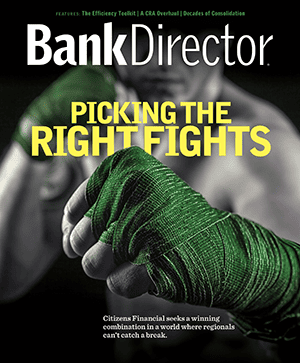
One Bank’s Approach to Improving Its Culture
Merriam-Webster defines culture as “the set of
shared attitudes, values, goals, and practices that characterizes an
institution or organization.” These attributes are central to a company’s
success.
Corporations with strong cultures tend to have financial performance that matches, according to studies that have investigated the relationship. The corporate review website Glassdoor found in 2015 that the companies on its “Best Places to Work” list, as well as Fortune’s “Best Companies to Work For” list, outperformed the S&P 500 from 2009 to 2014 by as much as 122%. In contrast, Glassdoor’s lowest-rated public companies underperformed the broader market over the same period.
Unlike the financial metrics banks rely on to measure their performance, culture is harder to measure and describe in a meaningful way. How can a bank’s leadership team – particularly its board, which operates outside the organization – properly oversee their institution’s cultural health?
“A lot of boards talk about the board being
the center of cultural influence within the bank, and that’s absolutely true,”
says Jim McAlpin, a partner at the law firm Bryan Cave Leighton Paisner and
leader of its banking practice group. As a result, they should “be mindful of
the important role [they] serve [in] modeling the culture and forming the
culture and overseeing the culture of the institution.”
Winter Haven, Florida-based CenterState Bank
Corp., with $17.1 billion in assets, values culture so highly that the board
created a culture-focused committee, leveraging its directors’ expertise.
CenterState wants “to create an incredible culture for their employees to enjoy and their customers to enjoy,” says David Salyers, a former Chick-fil-A executive who joined CenterState’s board in 2017. He’s also the author of a book on corporate culture, “Remarkable!: Maximizing Results through Value Creation.”
Salyers knew he could help the bank fulfill
this mission. “I want to recreate for others what Truett Cathy created for me,”
he says, referring to the founder of Chick-fil-A. “I love to see cultures where
people love what they do, they love who they do it with, they love the mission
that they’re on, and they love who they’re becoming in the process of
accomplishing that mission.”
Few banks have a board-level culture
committee. Boston-based Berkshire Hills Bancorp, with $13.2 billion in assets,
established a similar corporate responsibility and culture committee in early
2019 to oversee the company’s corporate social responsibility, diversity and
inclusion, and other cultural initiatives. Citigroup established its ethics,
conduct and culture committee in 2014, which focuses on ethical decision-making
and the global bank’s conduct risk management program – not the experience of
its various stakeholders.
CenterState’s board culture committee, established in 2018, stands out for its focus on the bank’s values and employees. Among the 14 responsibilities outlined in its charter, the committee is tasked with promoting the bank’s vision and values to its employees, customers and other stakeholders; overseeing talent development, including new hire orientation; advising management on employee engagement initiatives; and monitoring CenterState’s diversity initiatives.
The committee was Salyers’ suggestion, and he
offered to chair it. “I said, ‘What we need to do, if you want to create the
kind of culture you’re talking about, [is] we ought to elevate it to a board
level. It needs to get top priority,’” he says. “We’re trying to cultivate and
develop the things that will take that culture to the next level.”
As a result of the committee’s focus over the
past year, CenterState has surveyed staff to understand how to make their lives
better. It also created a program to develop employees. These initiatives are
having a positive impact on the employee experience at the bank, says Salyers.
Creating a culture committee could be a valuable practice for some boards, particularly for regional banks that are weighing transformative deals, says McAlpin. CenterState has closed 11 transactions since 2011. In January, it announced it will merge with $15.9 billion asset South State Corp., based in Columbia, South Carolina. The merger of equals will create a $34 billion organization.
“At the board level, there’s a focus on making
sure there is a common culture [within] the now very large, combined institution,”
says McAlpin, referencing CenterState. “And that’s not easy to accomplish, so
the board should be congratulated for that … to form a [culture] committee is a
very good step.”
CenterState’s culture committee leverages the
passion and expertise of its directors. Both Salyers and fellow director Jody
Dreyer, a retired Disney executive, possess strong backgrounds in customer
service and employee satisfaction at companies well-regarded for their
corporate culture. While this expertise can be found on the boards of Starbucks
Corp. and luxury retailer Nordstrom, few bank boards possess these traits.
Focusing on culture and the employee experience from the top down is vital to create loyal customers.
“The best companies know that culture trumps
everything else, so they are intentional about crafting engaging and compelling
environments,” Salyers wrote in his book. “A company’s culture is its greatest
competitive advantage, and it will either multiply a company’s efforts, or
divide both its performance and its people.”



